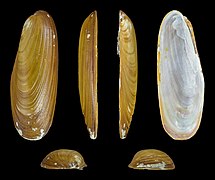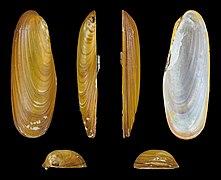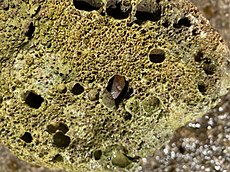
Bivalvia, in previous centuries referred to as the Lamellibranchiata and Pelecypoda, is a class of marine and freshwater molluscs that have laterally compressed bodies enclosed by a shell consisting of two hinged parts. As a group, bivalves have no head and they lack some usual molluscan organs, like the radula and the odontophore. The class includes the clams, oysters, cockles, mussels, scallops, and numerous other families that live in saltwater, as well as a number of families that live in freshwater. The majority are filter feeders. The gills have evolved into ctenidia, specialised organs for feeding and breathing. Most bivalves bury themselves in sediment, where they are relatively safe from predation. Others lie on the sea floor or attach themselves to rocks or other hard surfaces. Some bivalves, such as the scallops and file shells, can swim. Shipworms bore into wood, clay, or stone and live inside these substances.
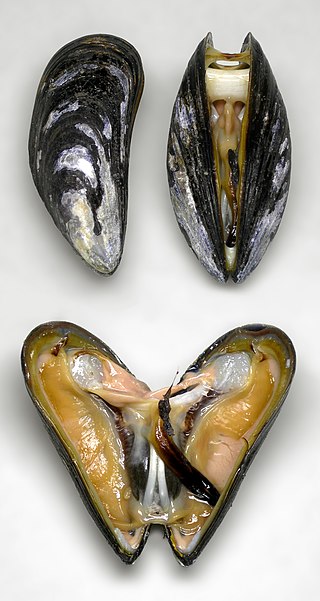
The blue mussel, also known as the common mussel, is a medium-sized edible marine bivalve mollusc in the family Mytilidae, the mussels. Blue mussels are subject to commercial use and intensive aquaculture. A species with a large range, empty shells are commonly found on beaches around the world.
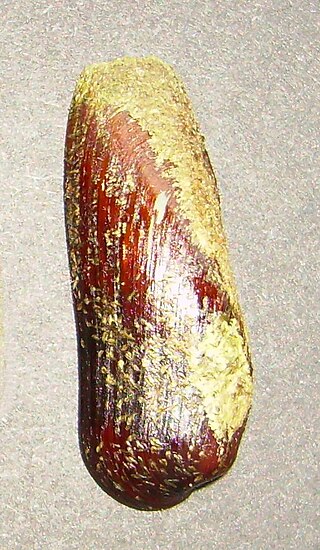
Lithophaga, the date mussels, are a genus of medium-sized marine bivalve molluscs in the family Mytilidae. Some of the earliest fossil Lithophaga shells have been found in Mesozoic rocks from the Alps and from Vancouver Island.
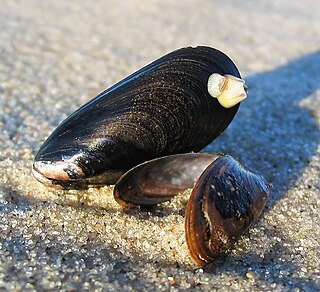
Mytilidae are a family of small to large marine and brackish-water bivalve molluscs in the order Mytilida. One of the genera, Limnoperna, even inhabits freshwater environments. Mytilidae, which contains some 52 genera, is the only extant family within the order Mytilida.
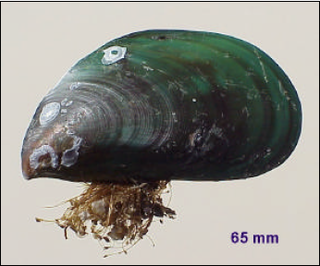
Perna viridis, known as the Asian green mussel, is an economically important mussel, a bivalve belonging to the family Mytilidae. It is harvested for food but is also known to harbor toxins and cause damage to submerged structures such as drainage pipes. It is native in the Asia-Pacific region but has been introduced in the Caribbean, and in the waters around Japan, North America, and South America.

The common cockle is a species of edible saltwater clam, a marine bivalve mollusc in the family Cardiidae, the cockles. It is found in waters off Europe, from Iceland in the north, south into waters off western Africa as far south as Senegal. The ribbed oval shells can reach 6 centimetres (2.4 in) across and are white, yellowish or brown in colour. The common cockle is harvested commercially and eaten in much of its range.

Perna perna, the brown mussel, is an economically important mussel, a bivalve mollusc belonging to the family Mytilidae. It is harvested as a food source but is also known to harbor toxins and cause damage to marine structures. It is native to the waters of Africa, Europe, and South America and was introduced in the waters of North America.
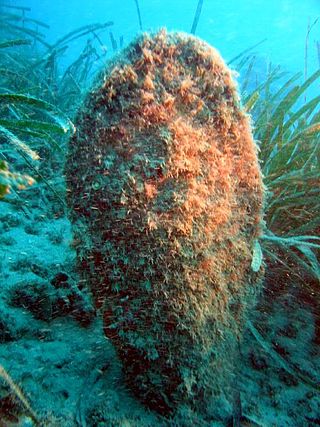
Pinna nobilis, whose common name is the noble pen shell or fan mussel, is a large species of Mediterranean clam, a marine bivalve mollusc in the family Pinnidae, the pen shells.

The Mediterranean mussel is a species of bivalve, a marine mollusc in the family Mytilidae. It is an invasive species in many parts of the world, and also an object of aquaculture.

Perna is a genus of mussels, marine bivalve molluscs in the family Mytilidae.

Lithophaga aristata, or the Scissor date mussel, is a species of bivalve mollusc in the family Mytilidae. It can be found along the Atlantic coast of North America, ranging from North Carolina to Texas and the West Indies.
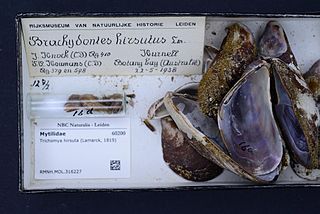
Trichomya is a monotypic genus of marine bivalve molluscs in the family Mytilidae, the mussels. The only species is Trichomya hirsuta which is endemic to southern and eastern Australia. Its common names include the hairy mussel, the greenling and the kelp greenling.

Gigantidas tangaroa is a species of deep-sea mussel, a marine bivalve mollusk in the family Mytilidae, the mussels.

Modiolus barbatus, the bearded horse mussel, is a species of "horse mussel", a marine bivalve mollusc in the family Mytilidae, the mussels.
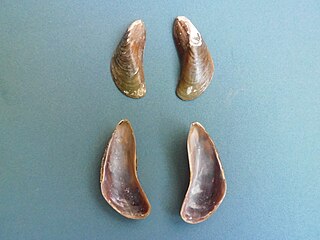
Mytella charruana is a bivalve, commonly known as the charru mussel. This species was discovered in Central and South America and by Alcide d'Orbigny, a French naturalist, in 1842. They are less than an inch long (2.5 cm), and range from brown to black in color.

Modiolus capax, common name fat horsemussel, is a species of "horse mussel", a marine bivalve mollusc in the family Mytilidae, the mussels. It was first described to science by American malacologist Timothy Abbott Conrad in 1837. The type specimen was collected in San Diego by Thomas Nuttall.

Brachidontes pharaonis is a species of mussel from the family Mytilidae. It is native to the Indian Ocean and the Red Sea, and has colonised the Mediterranean Sea where it is regarded as an invasive species.
Arcuatula perfragilis is a bivalve mollusc of the mussel family, Mytilidae, which has an Indo-Pacific distribution including the Red Sea. It has invaded the eastern Mediterranean from the Red Sea by way of the Suez Canal, a process known as Lessepsian migration.
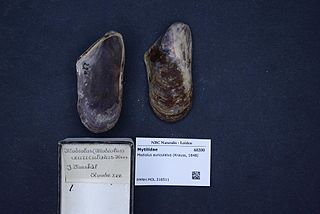
Modiolus auriculatus, the eared horse mussel, is a bivalve mollusc of the family, Mytilidae, which has a natural range in the Indian and Pacific Oceans. It has colonised the eastern Mediterranean Sea from the Red Sea by Lessepsian migration via the Suez Canal.
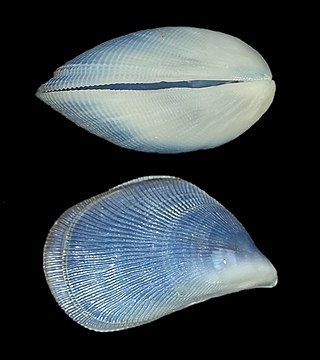
Septifer bilocularis is a marine bivalve species in the family Mytilidae, the mussels.


